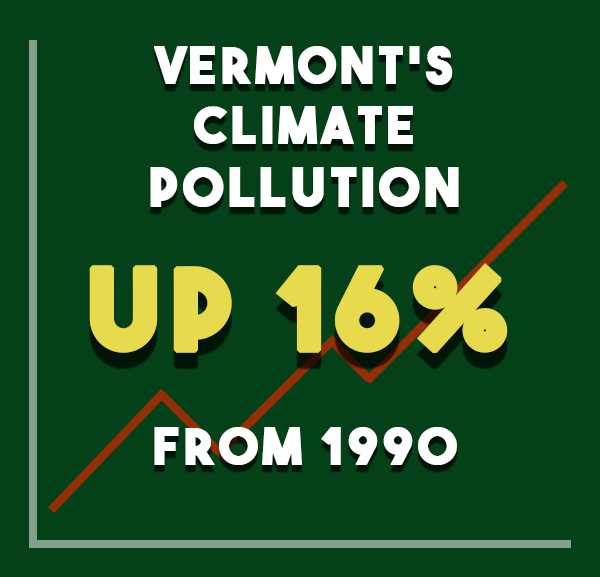On July 5th, while Vermonters were suffering through a deadly heatwave, Vermont’s Department of Environmental Conservation released the latest Vermont Greenhouse Gas Emissions Inventory — and it’s scary stuff. Detailing Vermont’s greenhouse gas (GHG) pollution from 1990-2015, this report highlights a troubling trend: Vermont’s climate pollution is up 16% from 1990 levels. Vermont’s climate pollution has been steadily on the rise since 2011, with transportation (43.3%), residential/commercial (i.e. heating — at 23.9%), and agriculture (11.4%) as the top contributing sectors.
We are accelerating in the wrong direction. Every year it is getting harder to reach our state’s climate and energy commitments. In fact, we’ve already missed our state goal of reducing GHG emissions to 25% below 1990 levels by 2012, and this report highlights how we’re straying even further from accomplishing our state goal of a 50% decrease by 2028.
At VPIRG, we have long believed that we cannot afford to wait any longer to act on climate — we need bold policies that are going to significantly propel Vermont towards climate action and hitting our state’s ambitious, and necessary, climate and energy commitments.
The reality is that Vermont has accomplished modest gains in renewable energy, electrification and efficiency in recent years — most notably the Renewable Energy Standard (RES), which went into effect in 2017 (and therefore is not reflected in the numbers of this report, which only go through 2015). The RES requires utilities to provide increasing amounts of renewable energy to Vermonters, ramping up over time through 2032. It also requires them to help more and more Vermonters reduce their fossil fuel use for heating and transportation, beginning the process of chipping away at some of the hardest carbon pollution to eliminate. Learn more about Vermont’s Renewable Energy Standard here.
In addition to the RES, we — alongside our allies and members — have fought for stronger efficiency standards, low-income weatherization, increased access to solar energy, a ban on fossil fuel infrastructure and a price on the pollution that’s causing global warming, all while holding the line on endless rollbacks coming from Washington D.C. and even from Vermont’s own governor Phil Scott. Without the dedication and support of our members and allies, the fact of the matter is that we’d be well above the 16% increase in emissions.
The truth though is that “less bad” isn’t nearly good enough. We can’t continue to stem the tide — we need to redirect the dial — NOW.
We need bold and equitable policy solutions like a price on carbon pollution, a requirement of 100% renewable energy and electrifying Vermont’s transportation and heating sectors. We need to hold our elected leaders accountable on climate progress because it’s simply not enough to have good rhetoric devoid of action. We must continue to press Gov. Scott to walk the walk on climate, and encourage all candidates for office to take the No Fossil Fuel Money Pledge — not accepting any money from fossil fuel companies, executives or PACs. There’s so much we can — and must — do.
We look forward to continuing this difficult but necessary fight alongside our allies, our members and the overwhelming majority of Vermonters who are clamoring for bold climate action to protect the Vermont we love for generations to come.

